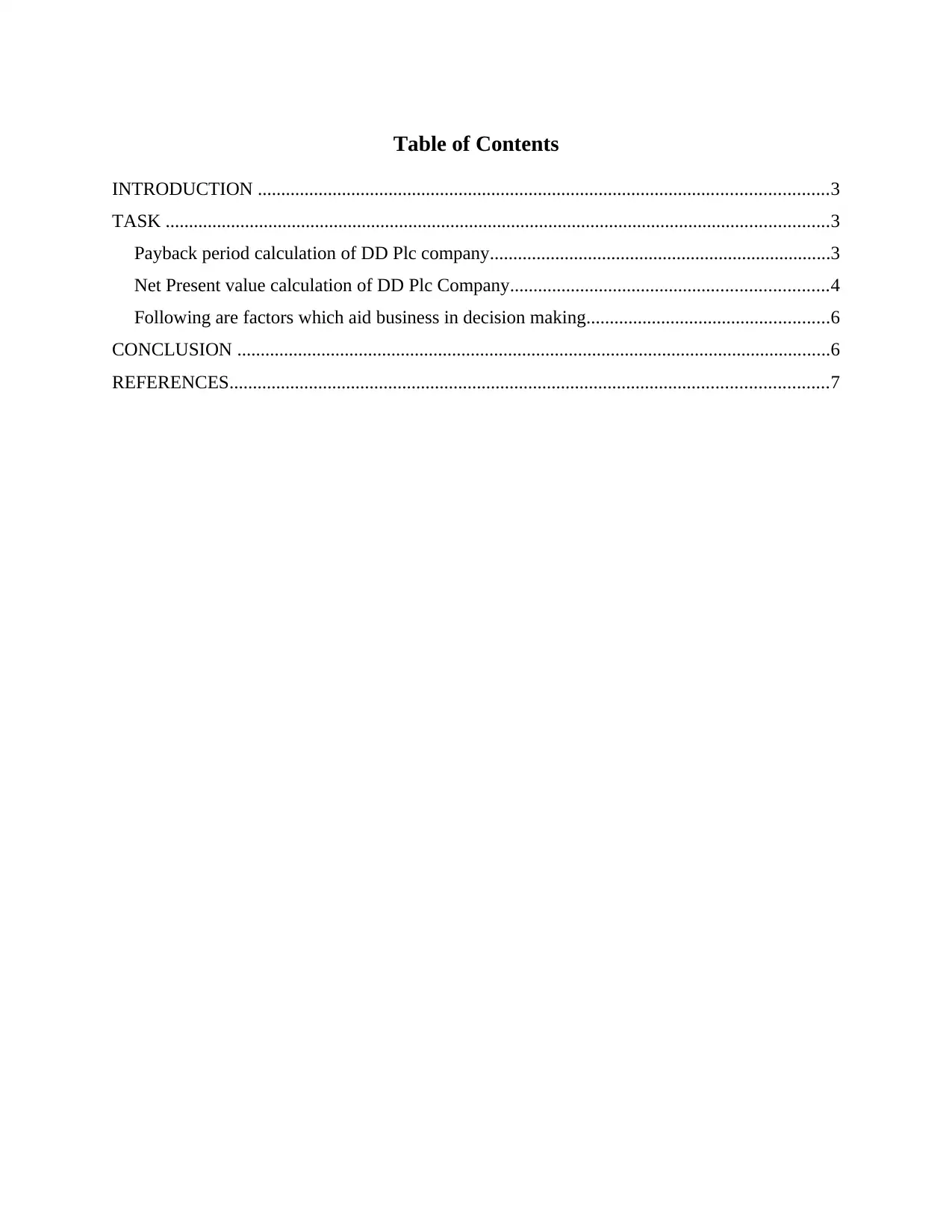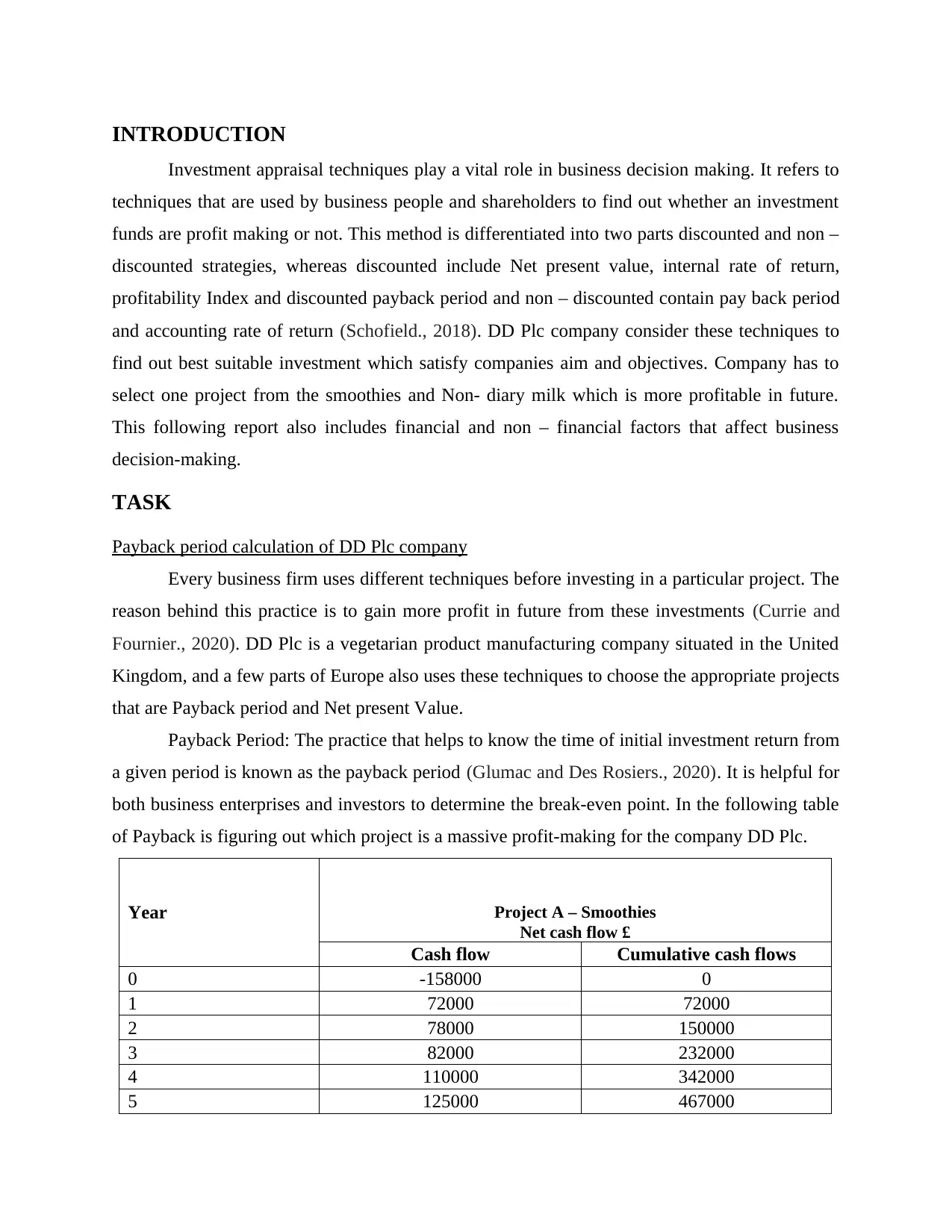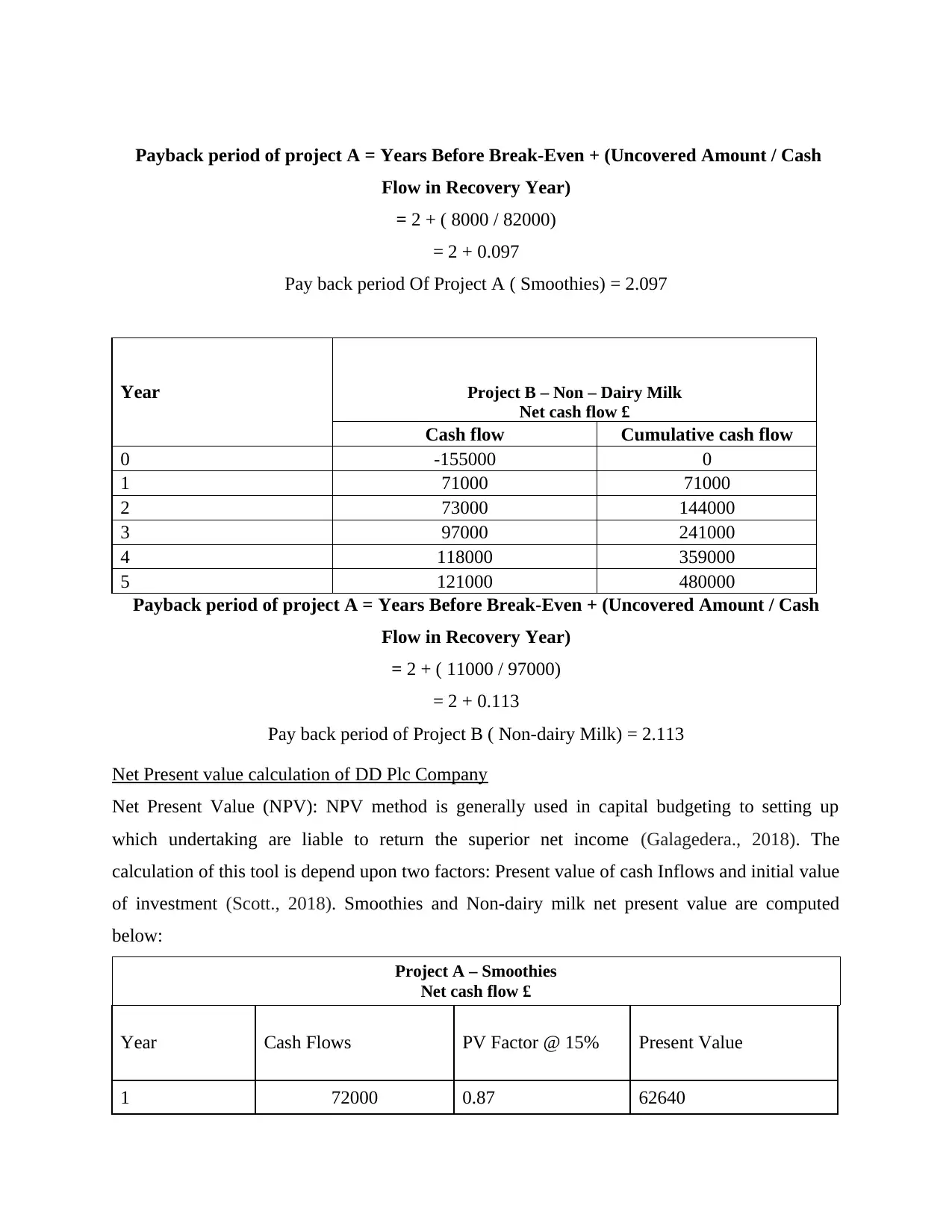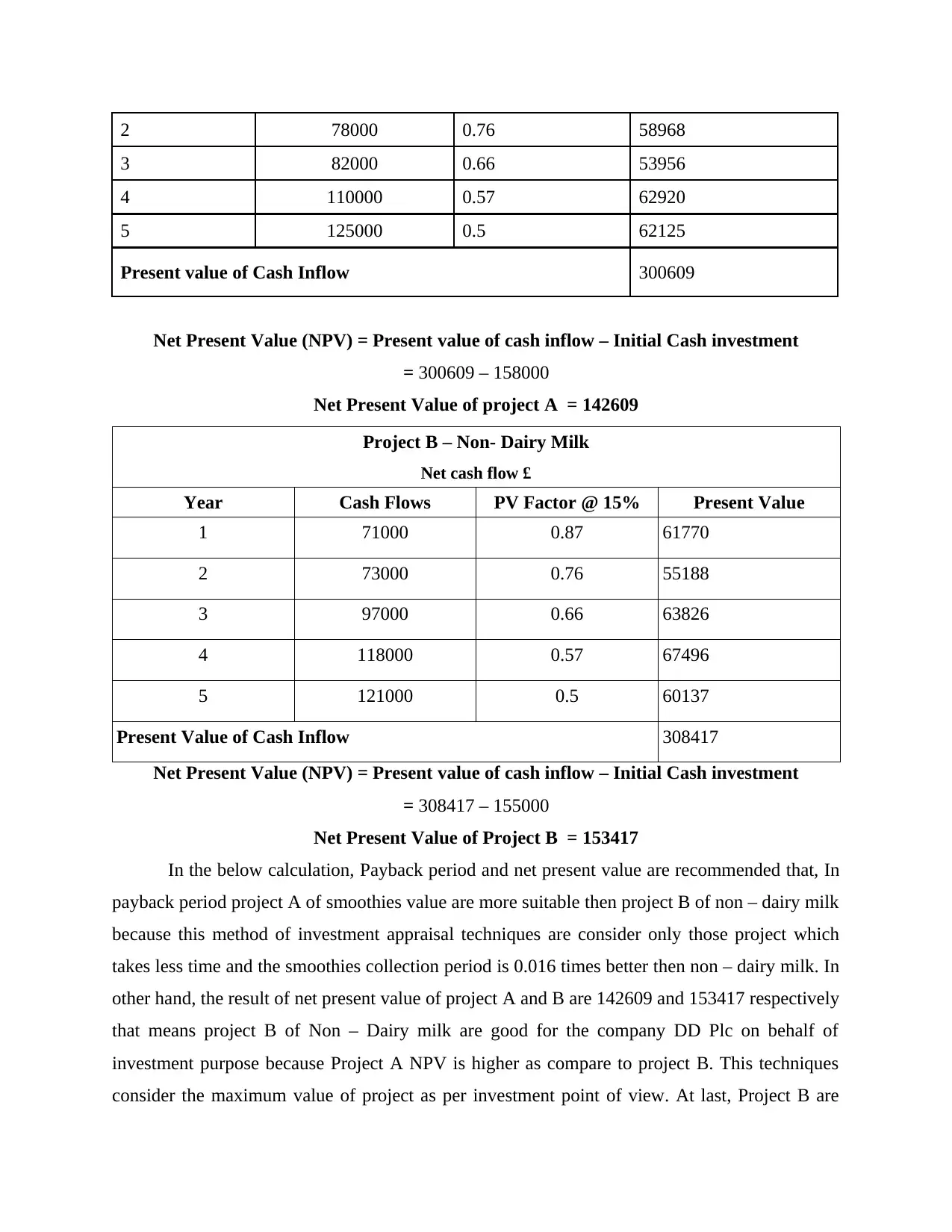Evaluating Investment Opportunities: Payback vs. NPV for DD Plc
VerifiedAdded on 2023/06/09
|8
|1430
|80
Essay
AI Summary
This essay provides a comprehensive analysis of investment appraisal techniques, focusing on the payback period and net present value (NPV) methods. It uses DD Plc, a vegetarian product manufacturing company, as a case study to evaluate two potential projects: smoothies and non-dairy milk production. The essay details the calculation of both payback periods and NPVs for each project, ultimately recommending the non-dairy milk project (Project B) based on its higher NPV. Additionally, the essay explores financial and non-financial factors that influence business decision-making, emphasizing the importance of both quantitative analysis and qualitative considerations for informed investment choices. Desklib offers a wide range of solved assignments and study resources for students.

Individual Essay
Paraphrase This Document
Need a fresh take? Get an instant paraphrase of this document with our AI Paraphraser

Table of Contents
INTRODUCTION ..........................................................................................................................3
TASK ..............................................................................................................................................3
Payback period calculation of DD Plc company.........................................................................3
Net Present value calculation of DD Plc Company....................................................................4
Following are factors which aid business in decision making....................................................6
CONCLUSION ...............................................................................................................................6
REFERENCES................................................................................................................................7
INTRODUCTION ..........................................................................................................................3
TASK ..............................................................................................................................................3
Payback period calculation of DD Plc company.........................................................................3
Net Present value calculation of DD Plc Company....................................................................4
Following are factors which aid business in decision making....................................................6
CONCLUSION ...............................................................................................................................6
REFERENCES................................................................................................................................7

INTRODUCTION
Investment appraisal techniques play a vital role in business decision making. It refers to
techniques that are used by business people and shareholders to find out whether an investment
funds are profit making or not. This method is differentiated into two parts discounted and non –
discounted strategies, whereas discounted include Net present value, internal rate of return,
profitability Index and discounted payback period and non – discounted contain pay back period
and accounting rate of return (Schofield., 2018). DD Plc company consider these techniques to
find out best suitable investment which satisfy companies aim and objectives. Company has to
select one project from the smoothies and Non- diary milk which is more profitable in future.
This following report also includes financial and non – financial factors that affect business
decision-making.
TASK
Payback period calculation of DD Plc company
Every business firm uses different techniques before investing in a particular project. The
reason behind this practice is to gain more profit in future from these investments (Currie and
Fournier., 2020). DD Plc is a vegetarian product manufacturing company situated in the United
Kingdom, and a few parts of Europe also uses these techniques to choose the appropriate projects
that are Payback period and Net present Value.
Payback Period: The practice that helps to know the time of initial investment return from
a given period is known as the payback period (Glumac and Des Rosiers., 2020). It is helpful for
both business enterprises and investors to determine the break-even point. In the following table
of Payback is figuring out which project is a massive profit-making for the company DD Plc.
Year Project A – Smoothies
Net cash flow £
Cash flow Cumulative cash flows
0 -158000 0
1 72000 72000
2 78000 150000
3 82000 232000
4 110000 342000
5 125000 467000
Investment appraisal techniques play a vital role in business decision making. It refers to
techniques that are used by business people and shareholders to find out whether an investment
funds are profit making or not. This method is differentiated into two parts discounted and non –
discounted strategies, whereas discounted include Net present value, internal rate of return,
profitability Index and discounted payback period and non – discounted contain pay back period
and accounting rate of return (Schofield., 2018). DD Plc company consider these techniques to
find out best suitable investment which satisfy companies aim and objectives. Company has to
select one project from the smoothies and Non- diary milk which is more profitable in future.
This following report also includes financial and non – financial factors that affect business
decision-making.
TASK
Payback period calculation of DD Plc company
Every business firm uses different techniques before investing in a particular project. The
reason behind this practice is to gain more profit in future from these investments (Currie and
Fournier., 2020). DD Plc is a vegetarian product manufacturing company situated in the United
Kingdom, and a few parts of Europe also uses these techniques to choose the appropriate projects
that are Payback period and Net present Value.
Payback Period: The practice that helps to know the time of initial investment return from
a given period is known as the payback period (Glumac and Des Rosiers., 2020). It is helpful for
both business enterprises and investors to determine the break-even point. In the following table
of Payback is figuring out which project is a massive profit-making for the company DD Plc.
Year Project A – Smoothies
Net cash flow £
Cash flow Cumulative cash flows
0 -158000 0
1 72000 72000
2 78000 150000
3 82000 232000
4 110000 342000
5 125000 467000
⊘ This is a preview!⊘
Do you want full access?
Subscribe today to unlock all pages.

Trusted by 1+ million students worldwide

Payback period of project A = Years Before Break-Even + (Uncovered Amount / Cash
Flow in Recovery Year)
= 2 + ( 8000 / 82000)
= 2 + 0.097
Pay back period Of Project A ( Smoothies) = 2.097
Year Project B – Non – Dairy Milk
Net cash flow £
Cash flow Cumulative cash flow
0 -155000 0
1 71000 71000
2 73000 144000
3 97000 241000
4 118000 359000
5 121000 480000
Payback period of project A = Years Before Break-Even + (Uncovered Amount / Cash
Flow in Recovery Year)
= 2 + ( 11000 / 97000)
= 2 + 0.113
Pay back period of Project B ( Non-dairy Milk) = 2.113
Net Present value calculation of DD Plc Company
Net Present Value (NPV): NPV method is generally used in capital budgeting to setting up
which undertaking are liable to return the superior net income (Galagedera., 2018). The
calculation of this tool is depend upon two factors: Present value of cash Inflows and initial value
of investment (Scott., 2018). Smoothies and Non-dairy milk net present value are computed
below:
Project A – Smoothies
Net cash flow £
Year Cash Flows PV Factor @ 15% Present Value
1 72000 0.87 62640
Flow in Recovery Year)
= 2 + ( 8000 / 82000)
= 2 + 0.097
Pay back period Of Project A ( Smoothies) = 2.097
Year Project B – Non – Dairy Milk
Net cash flow £
Cash flow Cumulative cash flow
0 -155000 0
1 71000 71000
2 73000 144000
3 97000 241000
4 118000 359000
5 121000 480000
Payback period of project A = Years Before Break-Even + (Uncovered Amount / Cash
Flow in Recovery Year)
= 2 + ( 11000 / 97000)
= 2 + 0.113
Pay back period of Project B ( Non-dairy Milk) = 2.113
Net Present value calculation of DD Plc Company
Net Present Value (NPV): NPV method is generally used in capital budgeting to setting up
which undertaking are liable to return the superior net income (Galagedera., 2018). The
calculation of this tool is depend upon two factors: Present value of cash Inflows and initial value
of investment (Scott., 2018). Smoothies and Non-dairy milk net present value are computed
below:
Project A – Smoothies
Net cash flow £
Year Cash Flows PV Factor @ 15% Present Value
1 72000 0.87 62640
Paraphrase This Document
Need a fresh take? Get an instant paraphrase of this document with our AI Paraphraser

2 78000 0.76 58968
3 82000 0.66 53956
4 110000 0.57 62920
5 125000 0.5 62125
Present value of Cash Inflow 300609
Net Present Value (NPV) = Present value of cash inflow – Initial Cash investment
= 300609 – 158000
Net Present Value of project A = 142609
Project B – Non- Dairy Milk
Net cash flow £
Year Cash Flows PV Factor @ 15% Present Value
1 71000 0.87 61770
2 73000 0.76 55188
3 97000 0.66 63826
4 118000 0.57 67496
5 121000 0.5 60137
Present Value of Cash Inflow 308417
Net Present Value (NPV) = Present value of cash inflow – Initial Cash investment
= 308417 – 155000
Net Present Value of Project B = 153417
In the below calculation, Payback period and net present value are recommended that, In
payback period project A of smoothies value are more suitable then project B of non – dairy milk
because this method of investment appraisal techniques are consider only those project which
takes less time and the smoothies collection period is 0.016 times better then non – dairy milk. In
other hand, the result of net present value of project A and B are 142609 and 153417 respectively
that means project B of Non – Dairy milk are good for the company DD Plc on behalf of
investment purpose because Project A NPV is higher as compare to project B. This techniques
consider the maximum value of project as per investment point of view. At last, Project B are
3 82000 0.66 53956
4 110000 0.57 62920
5 125000 0.5 62125
Present value of Cash Inflow 300609
Net Present Value (NPV) = Present value of cash inflow – Initial Cash investment
= 300609 – 158000
Net Present Value of project A = 142609
Project B – Non- Dairy Milk
Net cash flow £
Year Cash Flows PV Factor @ 15% Present Value
1 71000 0.87 61770
2 73000 0.76 55188
3 97000 0.66 63826
4 118000 0.57 67496
5 121000 0.5 60137
Present Value of Cash Inflow 308417
Net Present Value (NPV) = Present value of cash inflow – Initial Cash investment
= 308417 – 155000
Net Present Value of Project B = 153417
In the below calculation, Payback period and net present value are recommended that, In
payback period project A of smoothies value are more suitable then project B of non – dairy milk
because this method of investment appraisal techniques are consider only those project which
takes less time and the smoothies collection period is 0.016 times better then non – dairy milk. In
other hand, the result of net present value of project A and B are 142609 and 153417 respectively
that means project B of Non – Dairy milk are good for the company DD Plc on behalf of
investment purpose because Project A NPV is higher as compare to project B. This techniques
consider the maximum value of project as per investment point of view. At last, Project B are

good for the company DD plc for future decision-making and profitability because investment
appraisal techniques select net present value when situation are arises between NPV and Payback
period.
Following are factors which aid business in decision making
On the basis of Financial Factors:
It helps the business management to hold the monetary system and maximizing the
business performance for growth and expansion (Bharucha., 2019).
This factors provide accurate data from financial management system allows business
men to form sufficient fund control and investing decisions (Lee., 2021).
Financial factors include income, cost of goods sold (COGS), operating expenses, total
cost, etc.
On the basis of Non-financial factors:
This factors helps the company in developing the ability such as powering up the
business management system.
It helps business firms in protecting and dealing the upcoming threats and also help to
improve the business goodwill (Farrington., 2020).
It is necessary at the time of building trust in the market by fulfilling the needs of
customers and for communicating with shareholders and investors.
CONCLUSION
From the above report, it can be concluded that how effective the investment appraisal
techniques are for decision making and future profitability. It include two techniques that are
payback period and net present value along with calculation. It further observe both the project
resulted value and suggests that project B of non- diary milk are more suitable for the company
as compare to project A smoothies because the NPV are 10808 higher in project B. Financial and
non – financial factors are also explained on behalf of business decision making.
appraisal techniques select net present value when situation are arises between NPV and Payback
period.
Following are factors which aid business in decision making
On the basis of Financial Factors:
It helps the business management to hold the monetary system and maximizing the
business performance for growth and expansion (Bharucha., 2019).
This factors provide accurate data from financial management system allows business
men to form sufficient fund control and investing decisions (Lee., 2021).
Financial factors include income, cost of goods sold (COGS), operating expenses, total
cost, etc.
On the basis of Non-financial factors:
This factors helps the company in developing the ability such as powering up the
business management system.
It helps business firms in protecting and dealing the upcoming threats and also help to
improve the business goodwill (Farrington., 2020).
It is necessary at the time of building trust in the market by fulfilling the needs of
customers and for communicating with shareholders and investors.
CONCLUSION
From the above report, it can be concluded that how effective the investment appraisal
techniques are for decision making and future profitability. It include two techniques that are
payback period and net present value along with calculation. It further observe both the project
resulted value and suggests that project B of non- diary milk are more suitable for the company
as compare to project A smoothies because the NPV are 10808 higher in project B. Financial and
non – financial factors are also explained on behalf of business decision making.
⊘ This is a preview!⊘
Do you want full access?
Subscribe today to unlock all pages.

Trusted by 1+ million students worldwide

Paraphrase This Document
Need a fresh take? Get an instant paraphrase of this document with our AI Paraphraser

REFERENCES
Books and Journals
Bharucha, J.P., 2019. Determinants of financial literacy among Indian youth. In Dynamic
Perspectives on Globalization and Sustainable Business in Asia (pp. 154-167). IGI
Global.
Currie, G. and Fournier, N., 2020. Valuing public transport customer experience infrastructure–
A review of methods & application. Research in Transportation Economics. 83.
p.100961.
Dean, M. and Hickman, R., 2018. Comparing cost-benefit analysis and multi actor multi criteria
analysis: The case of Blackpool and the South Fylde Line. In Decision-making for
sustainable transport and mobility. Edward Elgar Publishing.
Farrington, D.P., 2020. Childhood risk factors for criminal career duration: Comparisons with
prevalence, onset, frequency and recidivism. Criminal Behaviour and Mental
Health, 30(4). pp.159-171.
Galagedera, D.U., 2018. Modelling superannuation fund management function as a two-stage
process for overall and stage-level performance appraisal. Applied Economics. 50(22),
pp.2439-2458.
Glumac, B. and Des Rosiers, F., 2020. Practice briefing–Automated valuation models (AVMs):
Their role, their advantages and their limitations. Journal of Property Investment &
Finance.
Lee, C., 2021. Factors influencing the credibility of performance measurement in
nonprofits. International Review of public Administration. 26(2). pp.156-174.
Schofield, J., 2018. Cost-benefit analysis in urban & regional planning. Routledge.
Scott, P., 2018. Introduction to Accounting. Oxford University Press.
Books and Journals
Bharucha, J.P., 2019. Determinants of financial literacy among Indian youth. In Dynamic
Perspectives on Globalization and Sustainable Business in Asia (pp. 154-167). IGI
Global.
Currie, G. and Fournier, N., 2020. Valuing public transport customer experience infrastructure–
A review of methods & application. Research in Transportation Economics. 83.
p.100961.
Dean, M. and Hickman, R., 2018. Comparing cost-benefit analysis and multi actor multi criteria
analysis: The case of Blackpool and the South Fylde Line. In Decision-making for
sustainable transport and mobility. Edward Elgar Publishing.
Farrington, D.P., 2020. Childhood risk factors for criminal career duration: Comparisons with
prevalence, onset, frequency and recidivism. Criminal Behaviour and Mental
Health, 30(4). pp.159-171.
Galagedera, D.U., 2018. Modelling superannuation fund management function as a two-stage
process for overall and stage-level performance appraisal. Applied Economics. 50(22),
pp.2439-2458.
Glumac, B. and Des Rosiers, F., 2020. Practice briefing–Automated valuation models (AVMs):
Their role, their advantages and their limitations. Journal of Property Investment &
Finance.
Lee, C., 2021. Factors influencing the credibility of performance measurement in
nonprofits. International Review of public Administration. 26(2). pp.156-174.
Schofield, J., 2018. Cost-benefit analysis in urban & regional planning. Routledge.
Scott, P., 2018. Introduction to Accounting. Oxford University Press.
1 out of 8
Related Documents
Your All-in-One AI-Powered Toolkit for Academic Success.
+13062052269
info@desklib.com
Available 24*7 on WhatsApp / Email
![[object Object]](/_next/static/media/star-bottom.7253800d.svg)
Unlock your academic potential
Copyright © 2020–2025 A2Z Services. All Rights Reserved. Developed and managed by ZUCOL.
